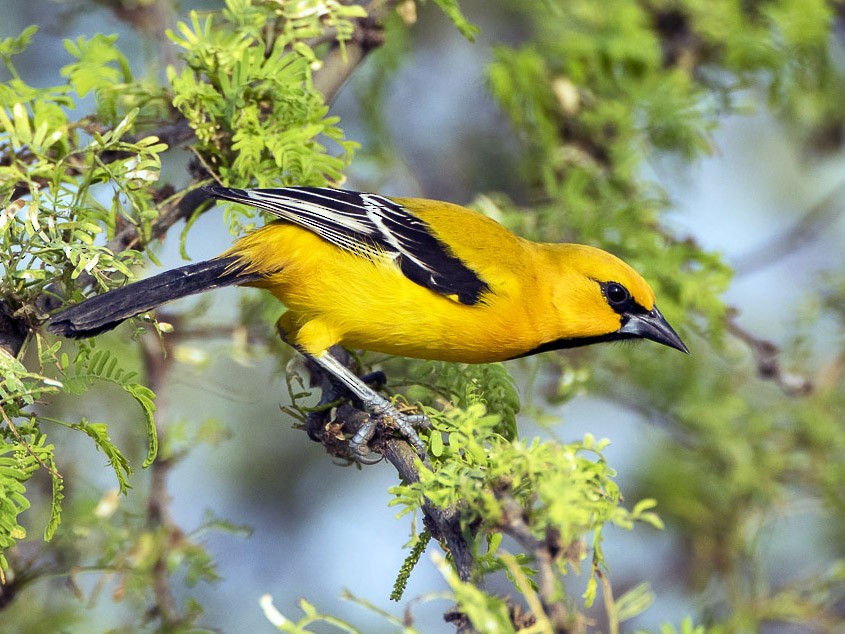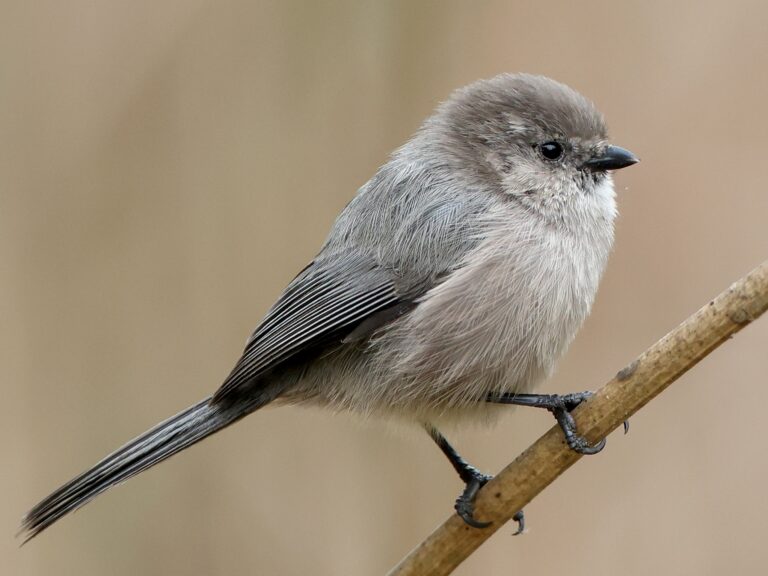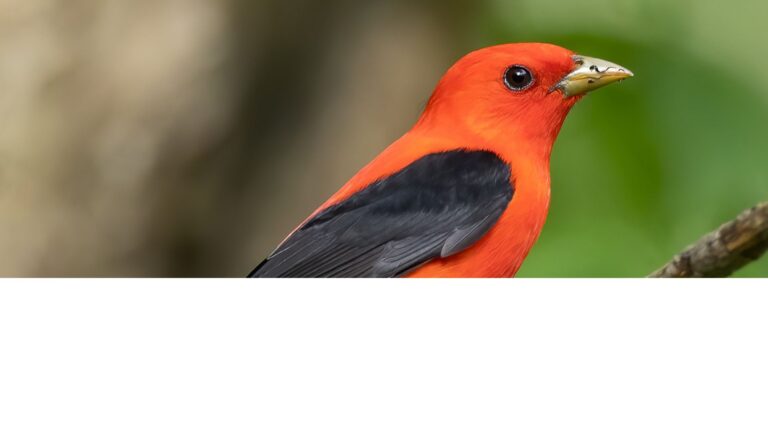15 Species of Oriole: Vibrant Birds That Brighten Our World
Orioles are striking birds known for their vibrant colors and melodic songs. These medium-sized songbirds belong to the Icteridae family and are particularly popular among birdwatchers across North America. There are approximately 33 species of orioles worldwide, with about 9 species commonly found in the United States, including the Baltimore Oriole, Bullock’s Oriole, and Orchard Oriole.
Each oriole species displays unique characteristics in terms of appearance, habitat preferences, and behaviors. They typically feature bold patterns of orange, yellow, or chestnut contrasted with black or olive colors. Orioles are known for their distinctive hanging nests and their preference for feeding on nectar, fruits, and insects. Many species migrate seasonally between North and Central or South America, bringing their beauty to different regions throughout the year.
1) Baltimore Oriole
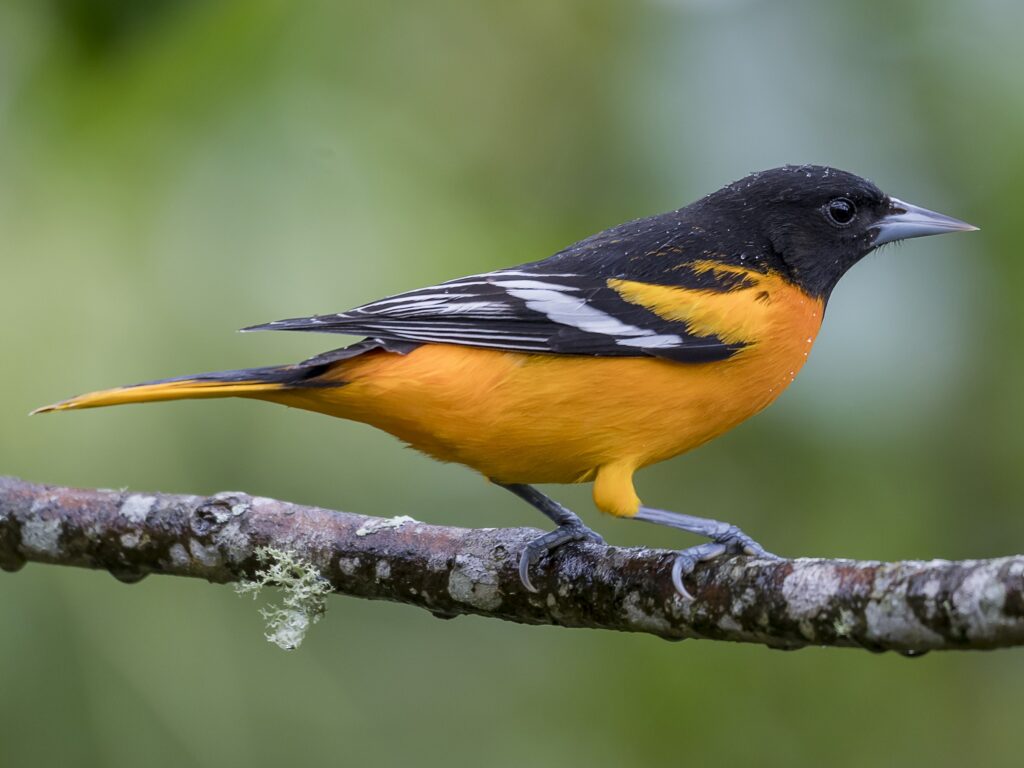
The Baltimore Oriole is one of the most recognizable bird species in the eastern United States. It’s a medium-sized songbird with a sturdy body, thick neck, and long legs, making it smaller and more slender than an American Robin.
Male Baltimore Orioles are known for their stunning bright orange body with a contrasting black head and bold white wingbar. This distinctive coloration is what led to the bird being called the “Baltimore bird” as early as the 1720s in the eastern colonies.
The species is the common oriole found throughout the eastern US. During winter months, Baltimore Orioles migrate to northern South America, traveling impressive distances for their size.
When comparing them to other oriole species, Baltimore Orioles are noticeably larger than Orchard Orioles. Male Orchard Orioles have a rich chestnut coloration, never displaying the bright orange that makes the Baltimore Oriole so distinctive.
Baltimore Orioles are part of a diverse family, with eight oriole species found across the United States. Among these species, the Baltimore Oriole remains one of the most iconic and beloved by birdwatchers.
2) Bullock’s Oriole
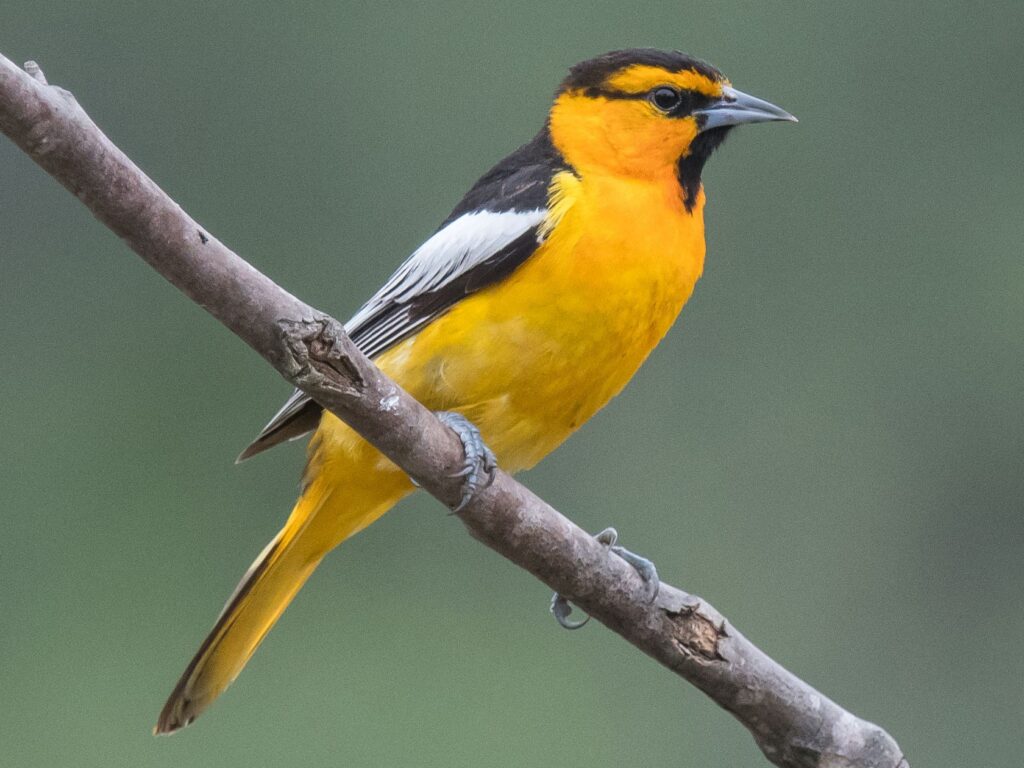
Bullock’s Oriole is the western counterpart to the Baltimore Oriole. These medium-sized songbirds have slim bodies and medium-long tails, similar to other orioles.
Adult males are striking with bright orange faces, black eyelines, and large white patches on their wings. They have orange-yellow bodies with black on their backs and throats.
Female Bullock’s Orioles are more subtle in coloration. They display yellowish-gray plumage with grayish-brown wings and pale wing bars.
Bullock’s Orioles breed throughout most of the western United States, parts of southwestern Canada, and northeastern Mexico. They prefer riparian areas with tall trees near open spaces.
During winter, these birds migrate to Mexico where they spend the colder months. Their migration pattern is quite predictable, returning to breeding grounds each spring.
Like other orioles, they build distinctive hanging nest pouches woven from plant fibers. These nests often hang from the outer branches of tall trees.
Bullock’s Orioles eat insects, fruits, and nectar. They can often be attracted to backyards with orange halves, sugar water, or specialized oriole feeders.
3) Orchard Oriole
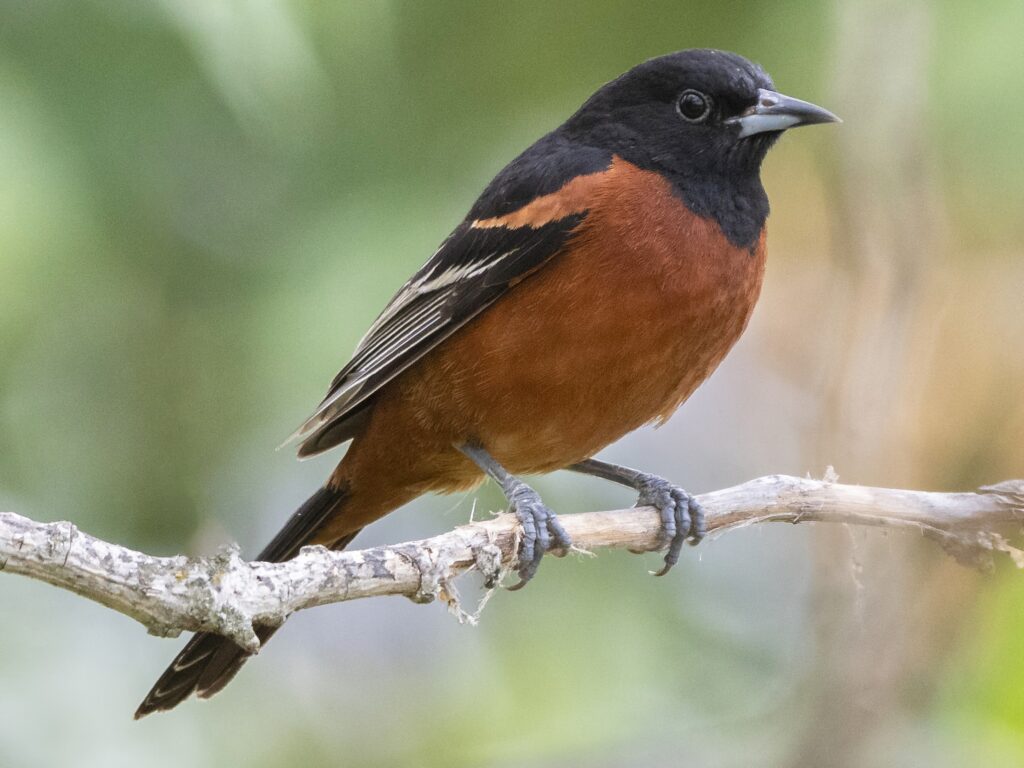
The Orchard Oriole is the smallest oriole species in North America. They measure between 5.9-7.1 inches in length and weigh just 0.6-1.0 ounces, with a wingspan of about 9.8 inches.
Adult male Orchard Orioles display a distinctive rich chestnut-brown coloration with a black head, making them unique among orioles. Females look quite different, with dull yellow-green plumage and white wingbars.
These slim songbirds have medium-length tails, rounded heads, and straight, sharply pointed bills. Their compact size makes them larger than warblers and vireos but smaller than other oriole species.
Orchard Orioles can sometimes be confused with Baltimore Orioles, but the latter are larger and the males show bright orange rather than chestnut coloration. Female Orchard Orioles may also be mistaken for female Baltimore, Bullock’s, or Hooded Orioles.
They prefer open woodland habitats, particularly near water sources. As their name suggests, they often inhabit orchards and can be found in parks, gardens, and riparian areas as well.
4) Scott’s Oriole

Scott’s Oriole (Icterus parisorum) is a striking bird that lives mainly in dry areas where yucca plants grow. The male has a bold black and yellow coloration that makes it easy to spot.
These medium-sized birds have a special relationship with yucca plants. They hunt for insects on these plants, drink nectar from yucca flowers, and even use yucca fibers to build their nests.
Male Scott’s Orioles have jet-black heads, backs, wings, and tails. Their bright yellow bellies and shoulders create a sharp contrast. Females look more subdued with olive-yellow bodies and darker wings.
You can find Scott’s Orioles in the southwestern United States and Mexico. They prefer dry habitats and are often seen on steep hillsides where yuccas are abundant.
Unlike some oriole species that visit backyard feeders regularly, Scott’s Orioles tend to stay in their natural desert habitats. They belong to the icterid family, which includes blackbirds, meadowlarks, and grackles.
Birdwatchers can sometimes confuse Scott’s Orioles with Hooded Orioles or Bullock’s Orioles, but the Scott’s stronger association with yucca plants and desert environments helps identify them.
5) Hooded Oriole

The Hooded Oriole (Icterus cucullatus) is a medium-sized songbird with a slender body and a longer, more rounded tail compared to other orioles. They also feature longer necks than their relatives, giving them a more delicate appearance.
Male Hooded Orioles can range in color from bright orange to pale yellow. They display a distinctive black mask and throat, along with a notable white patch on their shoulders.
Female Hooded Orioles are less vibrant than males but still have the characteristic shape of the species. Their coloration helps them blend into their natural habitats.
These birds are part of the New World oriole family and can be found across parts of North America. They share similarities with other oriole species like the Bullock’s Oriole and Scott’s Oriole, though each has unique identifying features.
Birdwatchers can identify Hooded Orioles by their slender profile and color pattern. Their long tails and distinctive markings make them stand out among the eight types of orioles found across America.
6) Audubon’s Oriole
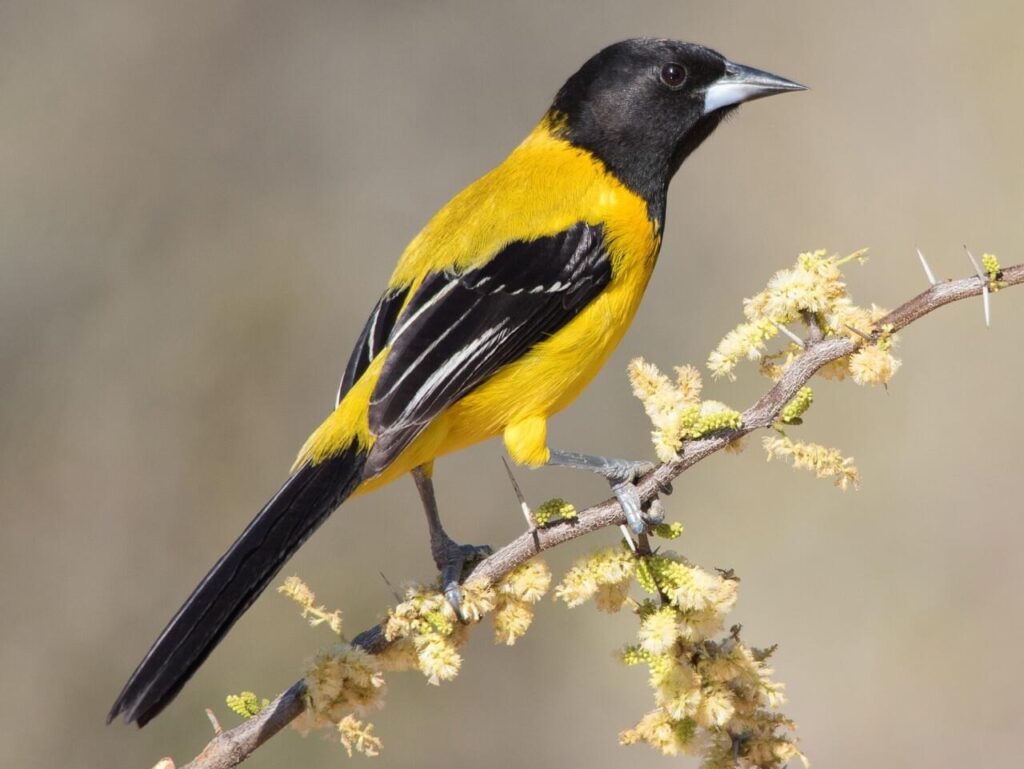
Audubon’s Oriole is a shy and secretive species with striking yellow and black plumage. It has a bright yellow body with a black throat, back, wings, and tail. Unlike the similar Scott’s Oriole, Audubon’s Oriole has a greenish-black back rather than a fully black one.
This large oriole has a limited range in the United States, found primarily in South Texas. It is more common in Mexico where it inhabits woodlands and brushy areas. Its secretive nature makes it one of the least known orioles that breed in North America.
Audubon’s Oriole pairs often stay together throughout the year. They typically forage together in wooded habitats, searching for insects and fruits among the trees and shrubs.
Despite their bright coloration, these birds can be difficult to spot due to their shy behavior. They tend to stay hidden in dense foliage, making them challenging for birdwatchers to observe.
The song of Audubon’s Oriole is distinctive, featuring pleasing whistles that rise and fall in pitch. These melodious calls often reveal the bird’s presence before it can be seen.
7) Altamira Oriole
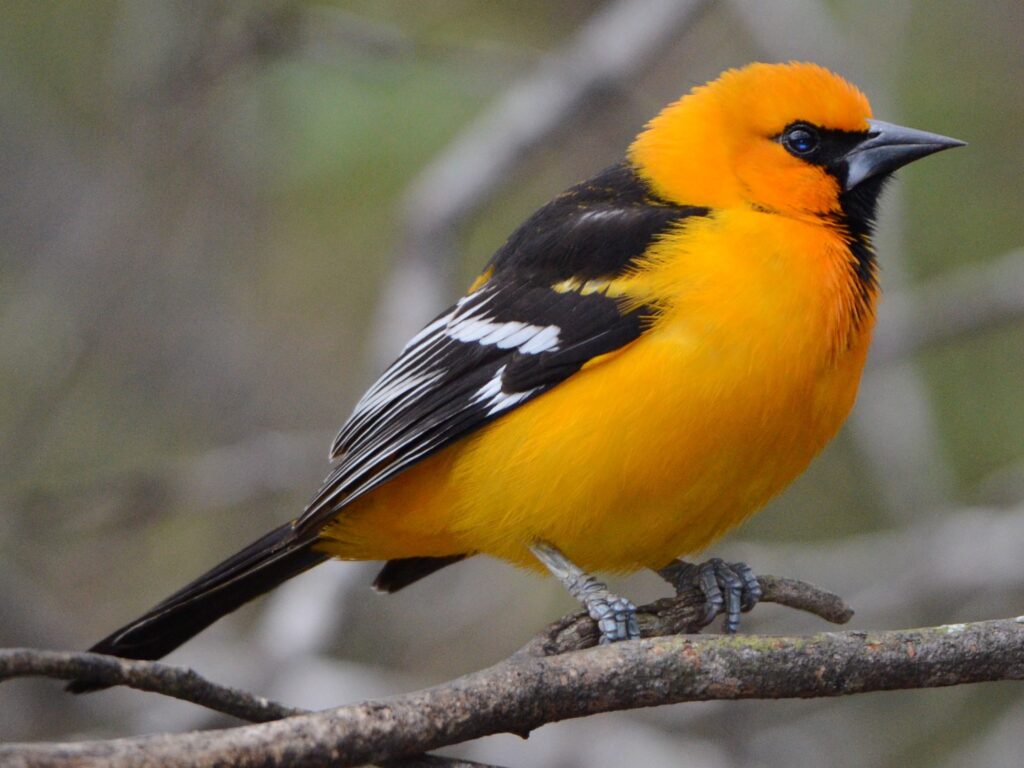
The Altamira Oriole is one of the largest and most colorful oriole species found in North America. It has a striking appearance with flame-orange body and black features including its throat, back, wings, and tail.
This tropical bird has a limited range in the United States, reaching only the Rio Grande Valley in southernmost Texas. In this region, it can be found year-round, though it’s more widespread throughout the subtropical lowlands of Mexico’s Gulf Coast and northern Central America.
Altamira Orioles are larger and stockier than the similar-looking Hooded Oriole. They have distinctive orange shoulder patches and thicker bills that help with identification.
These birds were previously known by other names including Lichtenstein’s Oriole and Black-throated Oriole. They prefer habitat near water and forest edges where they build distinctive hanging pouch nests.
Birdwatchers visiting the Rio Grande Valley often seek out this beautiful species as it represents one of the tropical birds that barely crosses into U.S. territory. Their bright coloration makes them relatively easy to spot despite their limited U.S. range.
8) Spot-Breasted Oriole
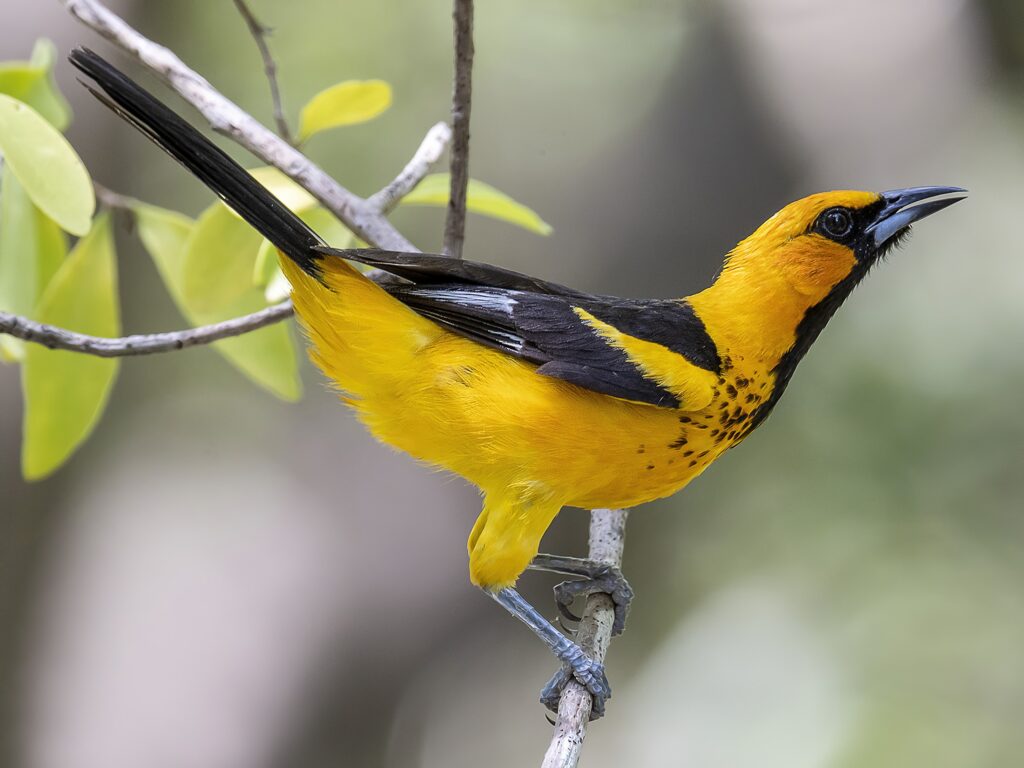
The Spot-Breasted Oriole is a striking bird with brilliant orange coloration and distinctive black markings. Adult birds have a bright orange head and body, contrasting with a black face, bib, back, and tail. As their name suggests, they have small black spots on the sides of their breast.
This medium-sized songbird is native to Mexico and Central America. They primarily inhabit the Pacific coastal lowlands, though they can be found locally in interior and Caribbean lowlands of northern Central America.
The Spot-Breasted Oriole has an interesting history in North America. In the 1940s, some escaped from captivity in the United States, where they had been kept as cage birds. These escapees established populations in new areas outside their native range.
Bird watchers often compare the Spot-Breasted Oriole to other similar-looking species like the Baltimore Oriole and Altamira Oriole. All share the characteristic orange and black coloration, but the distinct breast spotting helps identify the Spot-Breasted variety.
Despite being non-native to the United States, the Spot-Breasted Oriole has become reasonably well-known among North American birders.
9) Streak-backed Oriole
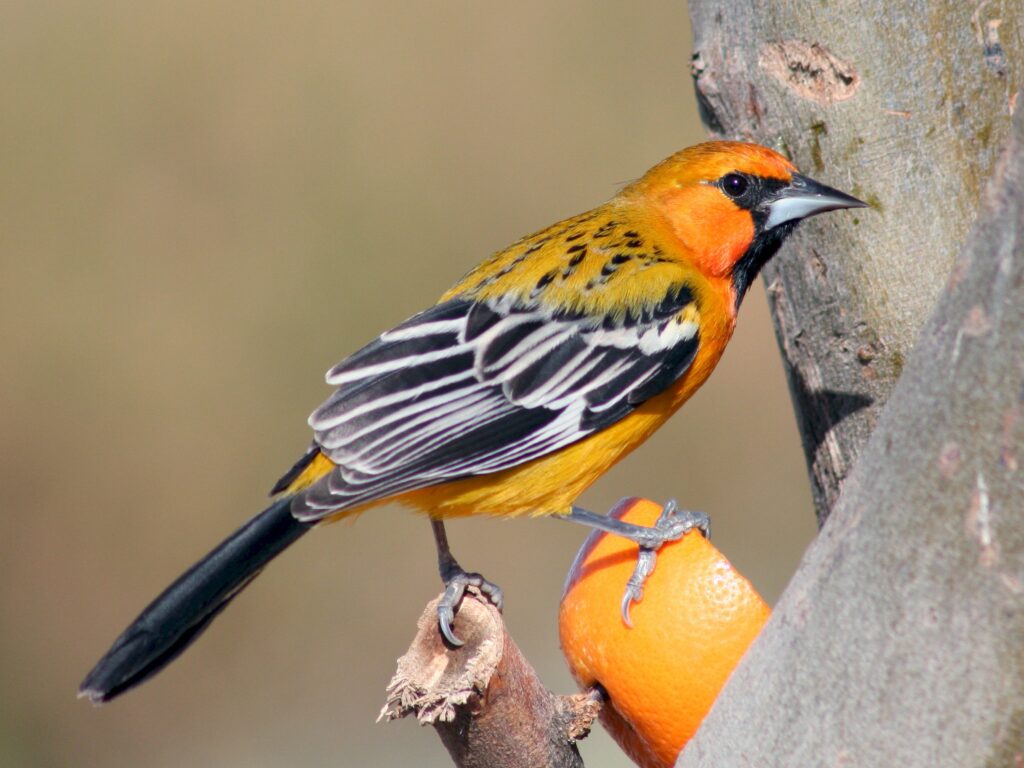
The Streak-backed Oriole (Icterus pustulatus) is a medium-sized passerine bird belonging to the icterid family. It gets its name from the distinctive streaks that run down its back.
This oriole is primarily found in Mexico and Central America, mostly along the Pacific Slope. It is very rare in the southwestern United States, making it an exciting find for birdwatchers in that region.
The Streak-backed Oriole thrives in diverse habitats including tropical woodlands, forest edges, and plantations. It also adapts well to human environments such as towns, gardens, and semi-open areas with hedges and scattered trees.
Unlike some other oriole species that migrate, the Streak-backed Oriole typically remains in its range year-round. Its adaptability to both natural and human-modified landscapes has helped it maintain stable populations.
These birds have beautiful orange and black plumage, similar to other oriole species, though the streaked pattern on their backs sets them apart. They feed on insects, fruits, and nectar, making them beneficial for pest control and pollination in their habitats.
10) Jamaican Oriole
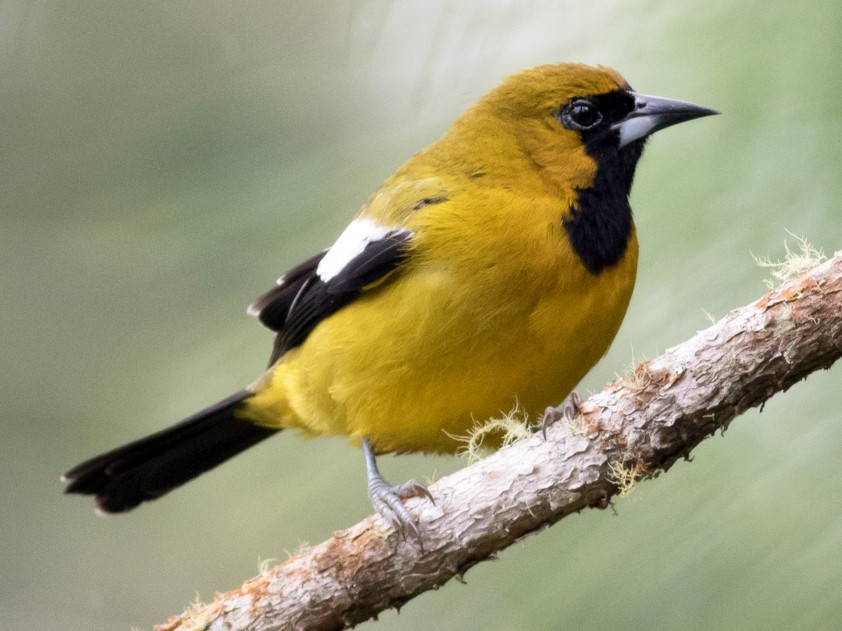
The Jamaican Oriole (Icterus leucopteryx) is a vibrant bird species belonging to the Icteridae family. This medium-sized bird is primarily known for its bright yellow plumage, which can sometimes have green or orange tints.
One of the most distinctive features of the Jamaican Oriole is its large white wing patches, which stand out against its colorful body. It also sports a characteristic black “beard” or throat patch that adds to its unique appearance.
This species is native to Jamaica and also occurs on San Andrés Island, which belongs to Colombia. A subspecies called bairdi can be found on Grand Cayman in the Cayman Islands.
The Jamaican Oriole prefers woodland habitats and gardens, where it can easily find fruits, which make up a significant part of its diet. Locals sometimes refer to this bird as “Banana Katie.”
Unlike some other oriole species that migrate, the Jamaican Oriole is a year-round resident in its range. It adds a splash of color to its tropical home and can often be spotted in both natural areas and more developed regions with sufficient tree cover.
11) Puerto Rican Oriole
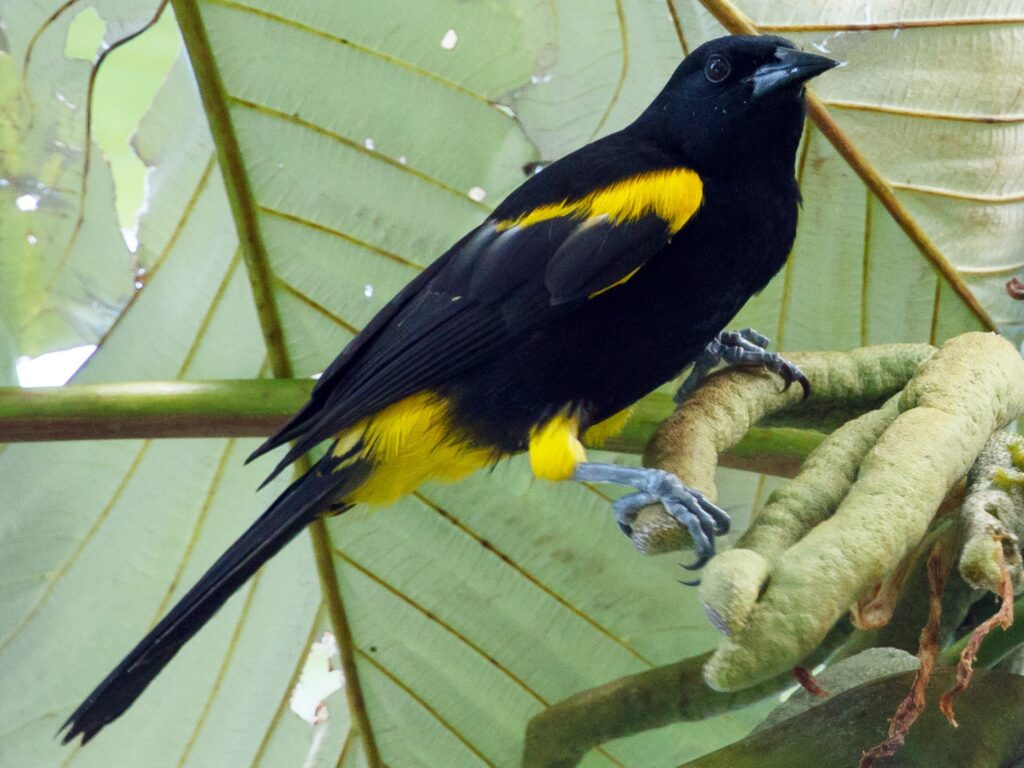
The Puerto Rican oriole (Icterus portoricensis) is a species of bird belonging to the Icteridae family. Also known locally as “calandria,” this bird is one of 15 species endemic to Puerto Rico.
This sleek bird inhabits wooded areas but often ventures into gardens and parks. It shows a clear preference for areas with palm trees.
The Puerto Rican oriole was once classified as part of the Greater Antillean Oriole group. In 2010, this group was split into four distinct species, with the Puerto Rican oriole being recognized as its own species.
When it comes to diet, this oriole feeds primarily on insects and small invertebrates. Spiders make up part of their regular meals. They also search for flowers and fruit as food sources.
As one of Puerto Rico’s endemic bird species, the Puerto Rican oriole contributes to the island’s biodiversity. This unique status may help generate ecotourism revenue for the region.
Their distinctive appearance and behavior make them fascinating subjects for birdwatchers visiting Puerto Rico’s forests and natural areas.
12) Cuban Oriole
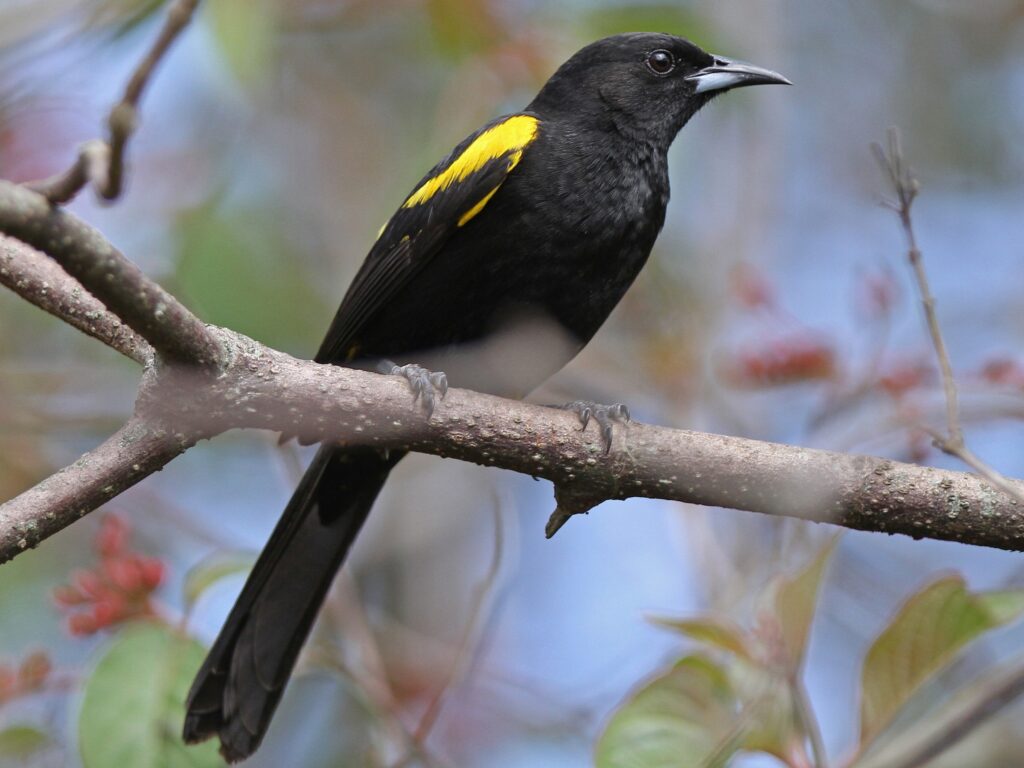
The Cuban Oriole is a sleek songbird endemic to Cuba. It belongs to the Icteridae family and has a scientific name of Icterus melanopsis. Adults measure about 20 cm (7.9 in) long, making them a medium-sized oriole species.
This bird is recognizable by its striking appearance. The adult is dressed primarily in black plumage, creating a dramatic contrast against Cuba’s lush landscapes.
The Cuban Oriole inhabits forests but occasionally ventures into gardens and parks. It particularly favors areas with palm trees, which can be found throughout the island. This makes the oriole relatively easy to spot in many frequently visited sites across Cuba.
In its search for food, the Cuban Oriole seeks out flowers and fruit. Its diet helps it fulfill an important ecological role as both pollinator and seed disperser within Cuban ecosystems.
The species has a large range across the island. Due to this widespread distribution, it does not currently meet the criteria to be considered Vulnerable according to conservation standards.
13) Bahama Oriole
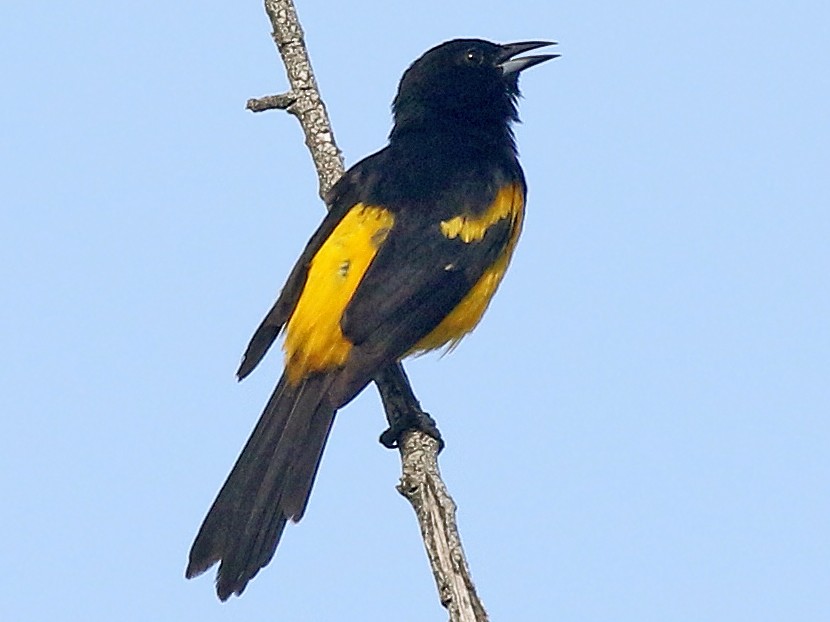
The Bahama Oriole is a rare songbird endemic to the Bahamas. It belongs to the New World blackbird family Icteridae and is scientifically known as Icterus northropi.
This striking bird has a black hood, back, wings, and tail, while its body is bright yellow, including the shoulders. The distinct black and yellow coloration makes it easily recognizable within its limited range.
Currently, the Bahama Oriole is restricted to the Andros Island complex in the Bahamas. It was once considered one of the most endangered birds in the Caribbean, with early estimates suggesting fewer than 300 individuals remained.
However, recent research brings encouraging news. New studies indicate that the population might be several thousand individuals, approximately 10 times larger than previously thought.
Despite this positive update, the Bahama Oriole remains a species of conservation concern due to its extremely limited range. Conservation efforts continue to focus on protecting its habitat and monitoring population trends.
The bird represents an important part of the Bahamas’ unique biodiversity and serves as a flagship species for conservation in the region.
14) Trinidad Oriole
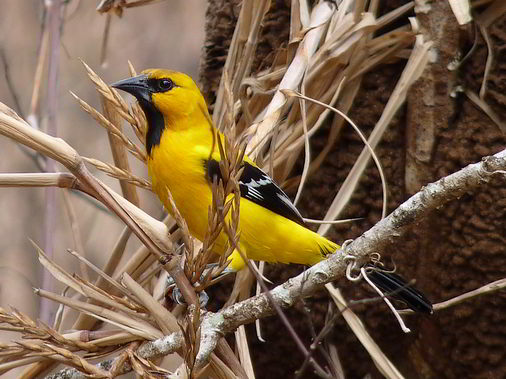
The Trinidad Oriole is a vibrant bird found in parts of South America, particularly in Trinidad. It’s closely related to the Yellow Oriole mentioned in the search results.
This oriole displays bright yellow plumage with black markings, making it stand out in its forest habitat. Males and females look similar, though males may have slightly brighter coloration.
Trinidad Orioles prefer tropical forests and woodland edges. They can often be spotted in areas with dense vegetation, as they like to stay hidden while foraging.
Their diet consists mainly of insects, fruits, and nectar. These birds use their pointed bills to probe for insects or extract nectar from flowers.
During breeding season, Trinidad Orioles build hanging nest pouches, typically suspended from tree branches. These intricate nests help protect their eggs from predators.
While not as well-known as some North American oriole species, the Trinidad Oriole is an important part of the Caribbean ecosystem. Birdwatchers visiting Trinidad often add this colorful species to their must-see lists.
15) Black-vented Oriole
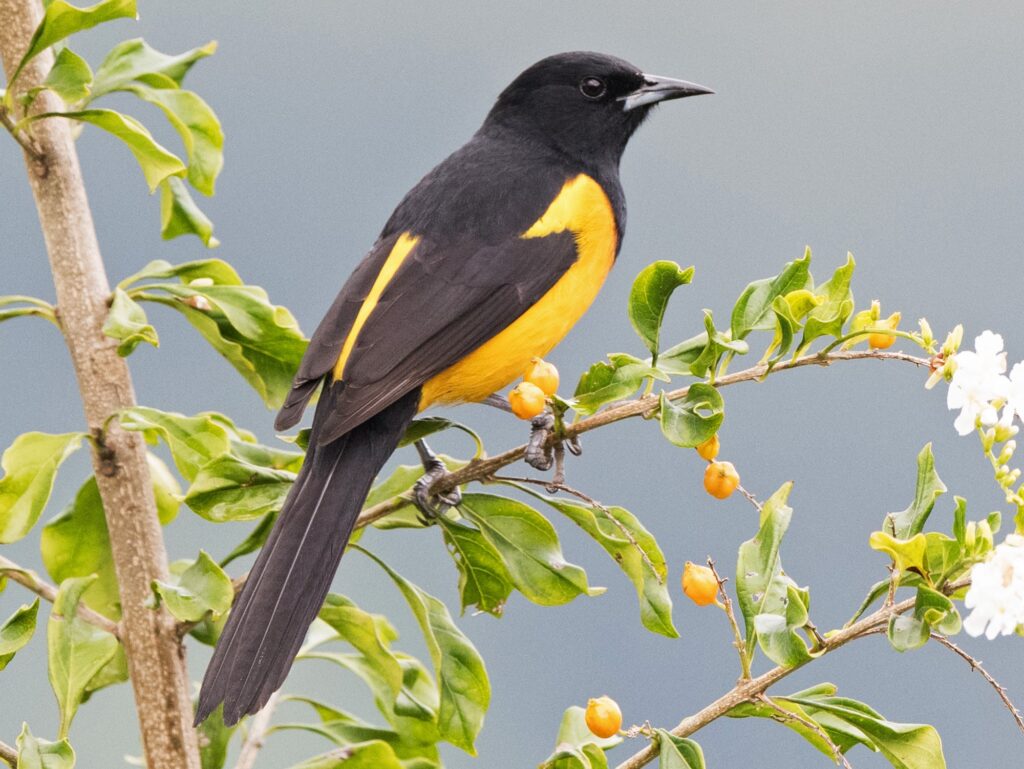
The Black-vented Oriole is a striking bird found throughout Middle America, ranging from Mexico south to Nicaragua. Its scientific name is Icterus wagleri, placing it in the Icteridae family with other orioles and blackbirds.
This attractive oriole has distinctive coloring with mainly black upperparts, head, neck, and tail. Its underparts display a vibrant orange-yellow coloration that contrasts beautifully with the dark features. As its name suggests, it has black venting, which helps identify it from similar oriole species.
Black-vented Orioles prefer scrubby woodlands and semi-open areas with tall trees. They adapt well to various habitats within their range, particularly in the interior and highland regions.
Some populations of these orioles are migratory, moving to Pacific coast lowlands during winter months. Others remain resident in their territories year-round.
The species inhabits open woodland and scrubby environments across its distribution. They can be found in El Salvador, Guatemala, Honduras, and other parts of Central America in addition to Mexico.
Habitat and Distribution
Orioles inhabit a diverse range of environments across North and South America, with specific preferences for open woodlands and forest edges. These colorful birds adapt their living spaces seasonally, with many species undertaking impressive migratory journeys.
Natural Environments of Orioles
Orioles generally prefer semi-open habitats rather than dense forests. They thrive in deciduous woodlands, forest edges, orchards, and suburban areas with mature trees. Baltimore Orioles, one of the most recognizable species, favor leafy deciduous trees in open woodland settings and forest edges.
Many oriole species show a preference for riparian areas where trees line rivers and streams. The Orchard Oriole specifically seeks out environments with a mix of deciduous trees and open spaces, including riverside trees, orchards, and suburban landscapes.
Orioles typically build their distinctive hanging nest pouches high in trees, away from predators. These nests are carefully woven into the outer branches of tall trees, providing both protection and visibility of the surrounding area.
Migration Patterns
Most North American oriole species are migratory birds that breed in the United States and Canada during summer months. The Baltimore Oriole breeds throughout eastern and east-central North America before migrating to winter grounds.
During winter, many oriole species travel to Central America and northern South America where food is more abundant. This impressive journey can span thousands of miles, with birds navigating across the Gulf of Mexico in many cases.
Some southwestern oriole species maintain year-round residency in their territories, particularly those along the Mexico-U.S. border. Climate change has begun affecting traditional migration timing for many orioles, with some individuals now arriving at breeding grounds earlier in spring.
Orioles typically return to the same breeding areas year after year, showing remarkable site fidelity despite their long migrations.
Diet and Foraging Behaviors
Orioles have diverse diets that change with seasons and availability of food sources. Their feeding habits involve specific techniques for accessing different foods across their habitats.
Common Food Sources
Orioles consume a varied diet centered around insects, fruits, and nectar. During breeding season, many species like the Baltimore Oriole primarily feed on caterpillars, adult insects, and spiders. These protein-rich foods are essential for raising young.
Fruits form another major component of oriole diets. Most species prefer ripe fruits, which pass quickly through their digestive systems. The Baltimore Oriole shows particular interest in dark-colored fruits such as wild cherries and mulberries.
In winter months, many oriole species shift their diet. They rely more heavily on nectar and small fruits, especially those orioles that migrate to tropical regions. Audubon’s Oriole maintains a year-round diet of insects, spiders, and fruits.
Feeding Strategies
Orioles employ specialized foraging techniques to access their preferred foods. They are agile feeders, combing high branches of trees in search of insects, flowers, and fruit. Their slender, pointed bills are perfectly adapted for probing flowers and extracting hidden insects.
When feeding on insects, orioles use a technique called “gleaning” – carefully searching leaves and branches to pick off prey. Baltimore Orioles can be observed foraging high in tree canopies with heavy foliage, especially during breeding season.
For accessing nectar, orioles may pierce the base of flowers or use their brush-like tongues. Some species, like the Orchard Oriole, are selective feeders, choosing only fully ripened fruits and avoiding unripe ones.
Orioles often forage in dense vegetation, especially Audubon’s Oriole, which searches both in trees and occasionally on the ground for food resources.
Frequently Asked Questions
Orioles display significant differences between sexes, species, and regions. These distinctive traits help birdwatchers identify the various oriole species across North America.
What are the distinctive characteristics of female orioles across different species?
Female orioles typically have more subdued coloration than males. They often display yellowish-olive or grayish-yellow plumage rather than the bright orange or black seen in males.
Female Baltimore Orioles show a warm yellow-orange on their underparts with brownish wings. Female Bullock’s Orioles have a pale yellow head and underparts with grayish-brown backs.
Female Orchard Orioles are the most subtly colored, with primarily olive-yellow plumage throughout. Female Hooded Orioles display a more uniform yellow color than other species.
How can one differentiate between the male and female Baltimore Oriole?
Male Baltimore Orioles have bright orange underparts with a completely black head and back. Their wings feature white wing bars and patches of orange on the shoulders.
Females are noticeably duller with yellow-orange or yellowish-tan underparts. Their head and back appear brownish rather than black, and their wings have white wing bars similar to males but less defined.
Size differences are minimal between sexes, with both being smaller and more slender than an American Robin. Their songs also differ slightly, with males producing the species’ characteristic flute-like melody.
What are the key identifiers of orioles found in California?
Bullock’s Oriole is the most common oriole in California. Males display orange faces, black crowns, and large white wing patches. Their underparts are bright orange-yellow.
Hooded Orioles in California have more yellow-orange coloration. Males show a distinctive black throat patch and face mask with an otherwise orange-yellow body.
Scott’s Oriole can be found in southern California’s desert regions. They have striking black and yellow patterns, with males featuring bright yellow underparts and black heads and backs.
Which birds are commonly mistaken for orioles and how can they be distinguished?
Western Tanagers are often confused with orioles due to their orange-red head and yellow body. They lack the orioles’ slender build and have shorter, thicker bills.
American Goldfinches might be mistaken for female orioles. They are smaller, have shorter bills, and display distinctive undulating flight patterns that orioles don’t have.
Yellow-breasted Chats have yellow underparts similar to some orioles but are larger with a thicker body, longer tail, and completely different behavior patterns, typically skulking in dense brush.
How does the Audubon’s Oriole differ from the Baltimore Oriole in appearance and habitat?
Audubon’s Orioles have bright yellow bodies with black heads, backs, and wings. Unlike Baltimore Orioles with their orange coloration, Audubon’s maintain this yellow-black pattern in both sexes.
Their habitat differs significantly. Audubon’s Orioles prefer the brushlands and woodlands of southern Texas and northeastern Mexico. Baltimore Orioles occupy a much wider range across eastern North America.
Audubon’s Orioles tend to stay year-round in their limited range, while Baltimore Orioles migrate to Central and South America during winter months.
What are the visual differences between hooded Orioles and Orchard Orioles?
Hooded Orioles are more yellow-orange compared to male Orchard Orioles’ rich chestnut coloration. Hooded Orioles have a distinctive black throat patch and face mask that Orchard Orioles lack.
Size differences are notable. Hooded Orioles are larger and more slender, while Orchard Orioles are the smallest North American oriole species.
Female Hooded Orioles appear more uniformly yellow, while female Orchard Orioles have an olive-yellow appearance. Their bills also differ, with Hooded Orioles having slightly longer, more curved bills.
